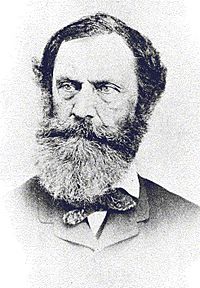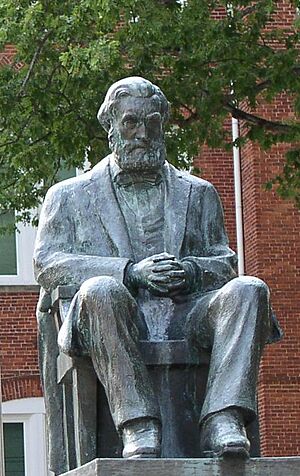Thomas Green Clemson facts for kids
Quick facts for kids
Thomas Green Clemson
|
|
|---|---|
 |
|
| Born | July 1, 1807 Philadelphia, Pennsylvania
|
| Died | April 6, 1888 (aged 80) |
| Education | Norwich University Collège de Sorbonne Royal School of Mines (Paris) |
| Occupation | Mining engineer Statesman Agriculturist College founder |
| Spouse(s) | Anna Maria Calhoun |
| Children | Floride Clemson Lee, John Calhoun Clemson |
| Parent(s) | Thomas Green Clemson III, Elizabeth Baker |
Thomas Green Clemson (born July 1, 1807 – died April 6, 1888) was an important American figure. He worked as an ambassador for the United States. He also led the U.S. Department of Agriculture for a time. Clemson served in the Confederate States Army during the Civil War. He is most famous for starting Clemson University in South Carolina.
Contents
Early Life and Education
Thomas Green Clemson was born in Philadelphia, Pennsylvania. His father was Thomas Green Clemson III, and his mother was Elizabeth Baker. His family had different religious backgrounds. His father's side was Quaker, and his mother was Episcopalian. Because of this, we don't know much about his own religious beliefs.
When Thomas was six years old, his father passed away in 1813. His father's cousin, John Gest, became the guardian for Thomas and his five brothers and sisters. Thomas and his siblings shared a large inheritance from their father.
Thomas started school in 1814. From 1823 to 1825, he attended a military academy in Vermont. This school is now known as Norwich University. After finishing his studies there, he returned to Philadelphia in 1825. He began to study Mineralogy, which is the study of minerals.
Studying in Paris
Around 1826, Clemson traveled to Paris, France, to continue his education. We don't know the exact date he left or returned. While in Paris, he wrote a letter to his mother. He mentioned that he was very interested in learning more.
In Paris, Clemson studied chemistry and worked with famous chemists. He trained at the Sorbonne and the Royal School of Mines. He earned a special diploma as an assayer from the Royal Mint. An assayer tests metals to find out what they are made of.
After returning to the U.S., he helped create new laws. These laws were meant to help agricultural education grow. Because he knew both French and German, he became a U.S. diplomat in Belgium. He worked there from 1844 to 1851. Historians say Clemson was a "Renaissance man." This means he was skilled in many different areas.
Agricultural Research
In 1843, Thomas Clemson bought a large piece of land in South Carolina. It was about 1,000 acres and was called "Canebrake." The name came from the many thick canes growing along the riverbank.
While he was working in Belgium, Clemson continued his studies in agriculture. He translated an important article from French to English. It was about how to get sugar from beets.
After his time in Belgium, Clemson bought another property in Maryland in 1853. He called it "The Home." He chose to live there because it was close to Washington, D.C. This gave him access to resources for his research. He studied Agricultural Chemistry and published his findings in science journals. He also attended meetings of agricultural societies.
One of his projects was studying a cattle disease called Texas Fever. He showed that cattle moving from the North to the South got sick. Cattle moving from the South to the North could spread the disease. His scientific work led him to speak at the Smithsonian Institution in 1858. Clemson continued his agricultural research for many years.
Marriage and Family Life
On November 13, 1838, Thomas Clemson married Anna Maria Calhoun. She was the daughter of John C. Calhoun. He was a famous Senator from South Carolina and the 7th Vice President of the United States.
After John C. Calhoun died, his family inherited his plantation, Fort Hill. This large property was near Pendleton, South Carolina. Thomas and Anna Clemson moved into Fort Hill in 1872. After Anna passed away in 1875, Thomas inherited Fort Hill. He lived there until he died on April 6, 1888. He is buried in Pendleton, South Carolina.
Clemson's Children
Thomas and Anna Clemson had four children. Their first child died as a baby in 1839. Their son, John Calhoun Clemson, was born in 1841. Their daughter, Floride Elizabeth Clemson, was born in 1842.
In 1855, their youngest daughter, Cornelia "Nina" Clemson, was born. Sadly, she died at age three in 1858 from scarlet fever. More sadness came in 1871. Their daughter Floride died on July 23. Just three weeks later, their only son John died on August 10. Thomas Green Clemson outlived all of his children.
Politics and Public Service
From 1860 to 1861, Clemson worked for President James Buchanan. He was the Superintendent of Agriculture. As the country moved closer to the Civil War, Clemson left this job in March 1861. He supported his adopted state of South Carolina.
After the attack on Fort Sumter in April 1861, Clemson moved from Maryland to South Carolina. In November 1861, he spoke to a group of farmers. He urged them to create a department of agriculture for the Confederate States. He believed it would help farming and spread scientific knowledge.
Diplomatic Work
Clemson served as a diplomat for the United States in Belgium. He held the position of Chargé d'affaires from 1844 to 1852. He got this job largely because of his father-in-law, John C. Calhoun. Calhoun was the Secretary of State at the time.
Clemson was very qualified for the role. His time studying in Paris helped him understand European culture. He also knew a lot about Europe's economy, politics, and social life. This helped him connect the United States with Belgium and other European countries. During his time in Belgium, the two countries signed a trade agreement. This agreement helped increase business between the U.S. and Belgium. King Leopold I of Belgium even gave Clemson an award, the Order of Leopold.
American Civil War Service
When the American Civil War began, Thomas Clemson was 54 years old. He joined the Confederate States Army. He worked in Arkansas and Texas, helping to develop mines for explosives. He was released from service in June 1865.
His son, Captain John Calhoun Clemson, also joined the Confederate Army. He spent two years as a prisoner of war. He was held in a Union prison camp on Johnson's Island in Ohio.
Founding Clemson University
Since Thomas Clemson outlived his wife and all his children, he decided to use his wealth to create something lasting. In the 1880s, he wrote his final will. In it, he asked for a special college to be built on his Fort Hill estate. He wanted it to be called The Clemson Agricultural College of South Carolina.
Clemson believed that education, especially in science, could lead to a better economy. He wanted to start an agricultural college because he felt the government didn't value farming education enough.
When the college opened in 1893, it was only for white male students. Clemson wanted to create a university that would not allow both black and white students to attend.
The military college opened its doors to 446 students. In 1964, Clemson Agricultural College was renamed Clemson University. Today, a statue of Thomas Green Clemson stands on the campus. His old home, Fort Hill, is also on campus. The town next to the campus, once called Calhoun, was renamed Clemson in 1943.


